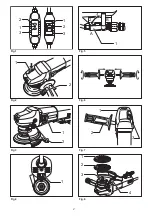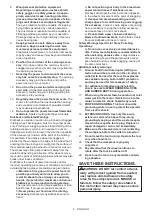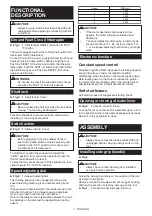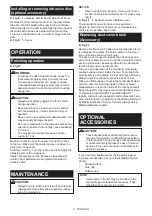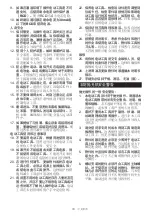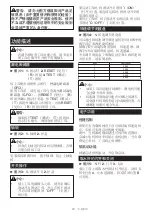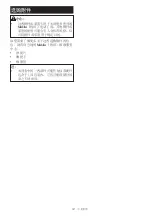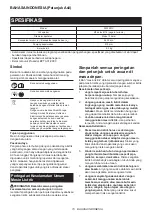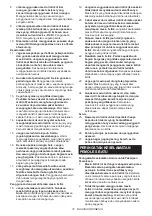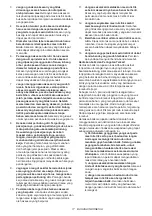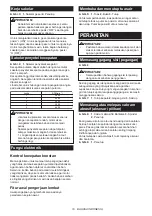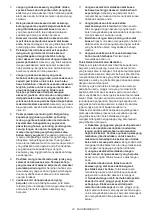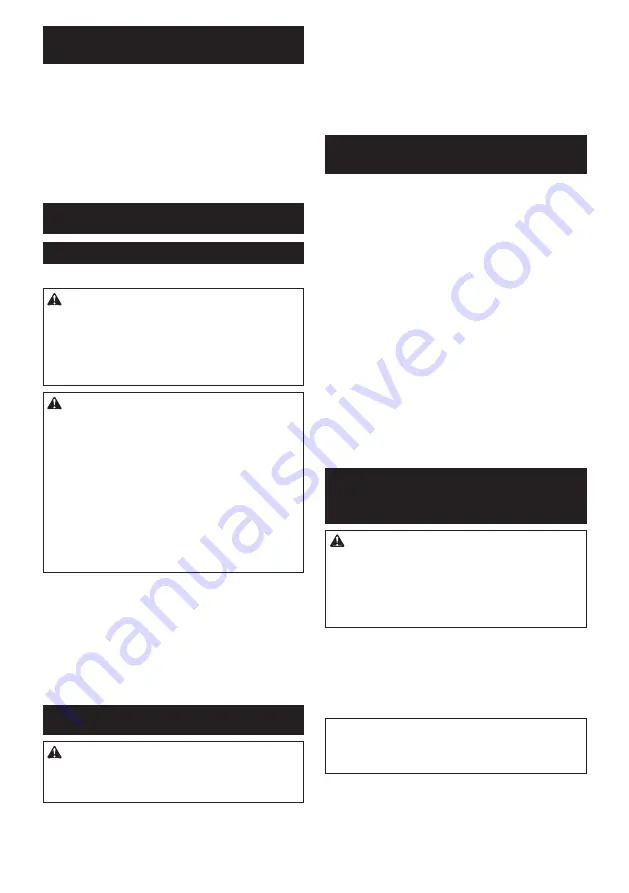
8 ENGLISH
Installing or removing abrasive disc
(optional accessory)
►
Fig.8:
1.
Abrasive disc
2.
Pad
3.
Spindle
4.
Cover
Remove all dirt or foreign matter from the pad. Screw
the pad onto the spindle with pressing the shaft lock.
Attach the disc to the pad so carefully that the edges of
disc and pad overlap each other without protruding.
To remove the abrasive disc, pull off its edge from the
pad.
►
Fig.9:
1.
Cover
OPERATION
Polishing operation
►
Fig.10
WARNING:
•
To reduce the risk of electric shock, check the
tool's water supply system to ensure there is
no damage to the seals (“O” rings) or hoses.
A damaged water supply system may result in
abnormal water flow to the tool which could be
dangerous.
CAUTION:
•
Always wear safety goggles or a face shield
during operation.
•
Never switch on the tool when it is in contact
with the workpiece, it may cause an injury to
operator.
•
Never run the tool without the abrasive disc. You
may seriously damage the pad.
•
Be sure to feed water to the abrasive disc during
operation. Failure to do so may cause breakage
to the tool.
•
The maximum permitted pressure of water
supply is 7 bar.
Make sure that the cock is closed. Connect the hose
to the tool. Make sure that water comes out when the
water lever is opened.
Hold the tool firmly. Turn the tool on and then apply the
abrasive disc to the workpiece.
Apply slight pressure only. Excessive pressure will
result in poor performance and premature wear to
abrasive disc.
MAINTENANCE
CAUTION:
•
Always be sure that the tool is switched off and
unplugged before attempting to perform inspec
-
tion or maintenance.
NOTICE:
•
Never use gasoline, benzine, thinner, alcohol or
the like. Discoloration, deformation or cracks may
result.
►
Fig.11:
1.
Exhaust vent
2.
Inhalation vent
The tool and its air vents have to be kept clean.
Regularly clean the tool's air vents or whenever the
vents start to become obstructed.
Replacing dust cover brush
(Accessory)
►
Fig.12
Replace the brush on the dust cover shortly after its tip
is damaged. To replace the brush, slide it in the direc
-
tion of arrow as shown in the figure.
The dust cover is used to reduce the risk of dust intru-
sion into tool body. Be sure to use the tool with the dust
cover in place when operating. Should it be damaged,
replace it with new one without fail.
Long use and operation of the tool using much water
causes buildup of dust inside the tool. To maintain the
product safety and operate the tool with high efficiency,
always check the exhaust vent at the back of tool.
When you find buildup of dust in that area, ask Makita
service center for cleaning inside of the tool. Never
disassemble or clean the inside of the tool by yourself.
Early request for cleaning is recommended at all times.
To maintain product SAFETY and RELIABILITY,
repairs, carbon brush inspection and replacement, any
other maintenance or adjustment should be performed
by Makita Authorized Service Centers, always using
Makita replacement parts.
OPTIONAL
ACCESSORIES
CAUTION:
•
These accessories or attachments are recom-
mended for use with your Makita tool specified
in this manual. The use of any other accessories
or attachments might present a risk of injury to
persons. Only use accessory or attachment for
its stated purpose.
If you need any assistance for more details regard-
ing these accessories, ask your local Makita Service
Center.
•
Abrasive discs
•
Side grip
•
Rubber pad
NOTE:
•
Some items in the list may be included in the
tool package as standard accessories. They
may differ from country to country.


